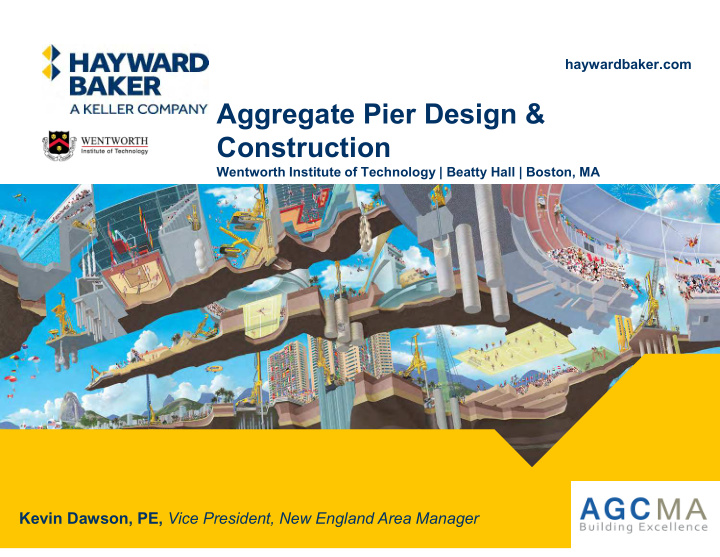



haywardbaker.com Aggregate Pier Design & Construction Wentworth Institute of Technology | Beatty Hall | Boston, MA Kevin Dawson, PE, Vice President, New England Area Manager
Presentation Outline What Wrap Up Why How When •Design •Installation 90
What 91
Vibro Piers = Aggregate Piers • Also known by names such as GeoPier, Rammed Aggregate Pier, Short Aggregate Pier, Compacted Aggregate Piers, Stone Column and others • Piers or columns of dense aggregate installed as foundation elements to support light to medium loads • Often referred to as an intermediate foundation system, i.e. not shallow but also not deep • Usually about 24 to 42 inches in diameter and about 10 to 30 feet deep 92
93
Aggregate Piers: How they work • Aggregate piers form a composite system with the surrounding soil • When confined laterally, the aggregate pier is much stronger and stiffer than the surrounding soil • Higher modulus columns attract load and dissipate it gradually with depth 94
This Not This 95
Why 96
reduce total & differential settlement Increase allowable bearing capacity 97
When 98
Selection of Ground Improvement Techniques Soil Type Governs the Ground Improvement Technique Mine Spoils Undocumented Fill Low Strength Cohesive Soils Loose Sand 99
Commercial & Industrial Historic Land Use 100
Filled Land & Former Industrial & Commercial Land Use 101
Private Industrial Site Redevelopment 102
Public Redevelopment – Filled Industrial Land 103
When Summary • Undocumented fill or loose soil less than 30’ thick • Appropriate loads (deep foundations or alternate ground improvement technique not required) • Less expensive alternate ground improvement techniques not viable • Cost/schedule impact of excavation and replacement not viable 104
How; Design 105
Aggregate Pier Design Methodology Design based on spring analogy: – Rigid footing: aggregate pier deflection equals matrix soil deflection – Stiff spring (aggregate pier) takes more load than the soft spring (matrix soil) 106
107 www.HaywardBaker.com
Total Settlement = Settlement from the Improved Zone + Settlement from the Unimproved Zone IMPROVED ZONE UNIMPROVED ZONE 108
Pier Testing: Modulus Verification Test Testing done either with a load frame and anchors or utilizing the vibratory rig as a counterweight 109
How; Installation 110
111
112
113
Wrap Up • Cost effective intermediate foundation solution for fill & loose native soil sites • Know the limits of the system • Alternate ground improvement systems or deep foundations may be best match for thick soft soil deposits or if improvement depth > 30’ • Market is extending the use of aggregate piers • Understand the risk/reward relationship 114
Recommend
More recommend